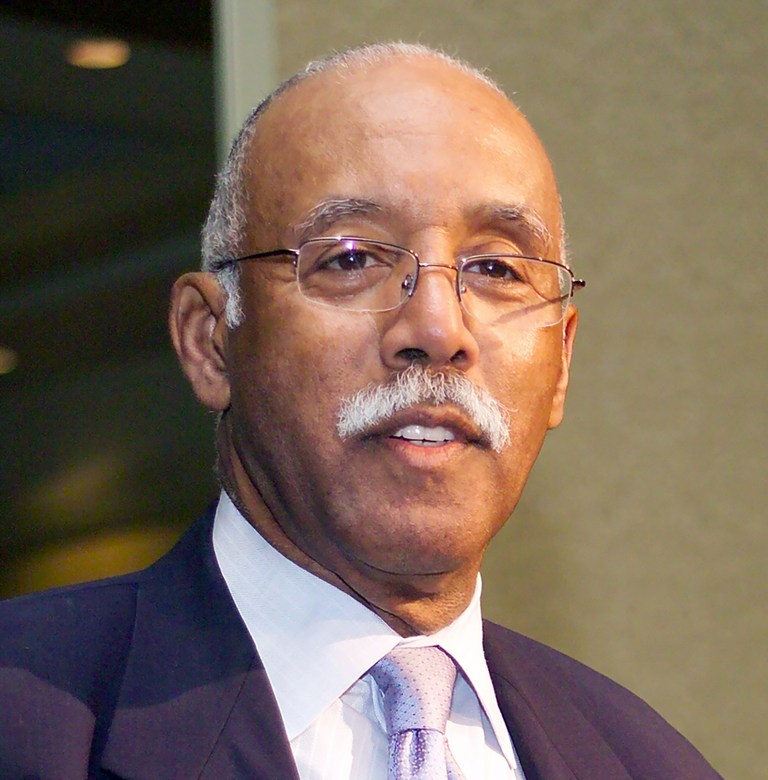
Julian M. Earls
Former Center Director, Glenn Research Center, Oct. 2003 - Dec. 2005
Julian Earls served as center director at NASA’s Glenn Research Center from October 1, 2003 until December 24, 2005. This period was dominated by the Columbia accident investigation, the Return to Flight effort, and the initial planning for the Constellation Program. Over the previous 30-plus years, Earls had held positions at every managerial level at the center.
Earls became interested in electrical engineering while growing up in Portsmouth, Virginia. Since the nearby Norfolk State University did not offer engineering degrees, he earned his bachelor’s degree in physics in 1964. There he learned that physicists could work in engineering. He then went on to earn a master’s degree in radiation biology from the Rochester School of Medicine and Dentistry in 1965. In September of that year, he was hired as a health physicist by NASA’s Lewis Research Center (today, NASA Glenn), which was NASA’s lead center in nuclear propulsion and power in the 1960s.
Earls left NASA briefly in 1968 to work for the Atomic Energy Commission. He returned later that year as head of Lewis’ Health Physics and Licensing Section. There he monitored radiation at the Cyclotron Facility and helped ready the Space Power Facility for nuclear testing. He also established a Radiation Safety Committee so the center could independently acquire radiation materials. In 1972 he earned both a Doctor of Public Health in radiation physics as well as the equivalent of a Master of Public Health in environmental health from the University of Michigan, while also serving as the chief of the center’s Environmental Health Office.
In 1972, NASA terminated its nuclear activities. Earls was named chief of the Environmental Health Office which sought to mitigate health dangers such a pollution, high noise levels, and asbestos. In 1983 he was named chief of Health Safety and Security Division where he managed occupational health, medical, safety, and security programs at Lewis and Plum Brook Station (today, NASA’s Neil Armstrong Test Facility).
Earls moved through several senior management positions in the 1990s. In 1992 he was named assistant deputy director for Business Resources Development, where he worked to improve ties to minority universities and businesses; in 1994 he became director of the Administration and Computer Services Directorate, which included the center’s logistics, computer services, human resources, and procurement services; in 1996 he was named deputy director of Operations and helped manage the center’s organization and resources during a period when the agency was undergoing Zero Base Review activities. In 2002 Earls was selected as the center deputy director and was responsible for the overall management of the center’s organizational objectives, direction and resource allocation.
On August 8, 2003, Glenn employees were informed that Earls would be replacing outgoing center director Donald Campbell on October 1. The center was in the midst of conducting an array of testing to support the Return to Flight effort following the loss of the Columbia shuttle earlier that year. Glenn, which was still adjusting to the aftermath of NASA’s Zero Base Review exercise in the mid-1990s, was also preparing for cuts in its aeronautics and science programs as the agency’s new Constellation Program was being developed. NASA Administrator Sean O’Keefe stated, “Julian’s selection brings stability and continuity to Glenn during this important transition.”
In an effort to stabilize the center and increase funding, Earls worked to create partnerships with other NASA centers, industry, and universities; seek reimbursable funding from external entities; and make it easier for outside organizations to lease Glenn facilities. Glenn also held a four-day technology showcase and open house in June 2004 to showcase the center’s activities. The event drew 35,000 visitors.
Earls implemented a reorganization in early 2004 that established a new Programs and Projects Directorate, which included all aeronautics, aeropropulsion, and space activities along the lines of the agency’s new project structure. It also created a new Center Operations Directorate, which included logistics, technical information, procurement, security, and safety activities. The result was a consolidation of all management for programs and projects, institutional work, and systems analysis. A new business component was also added.
Earls retired in December 2005 after 40 years at the center. From 2006 to 2019 he was a Cleveland State University as an executive in residence and served as the president of the Entrepreneurial Engagement Ohio non-profit. He has been involved in numerous other community activities.
Earls’ many awards include the NASA Exceptional Achievement Medal, the NASA Outstanding Leadership Medal, and two Presidential Rank Award for Meritorious Service. He graduated from the Harvard Business School and has been presented with several honorary degrees.
Additional Resources





























